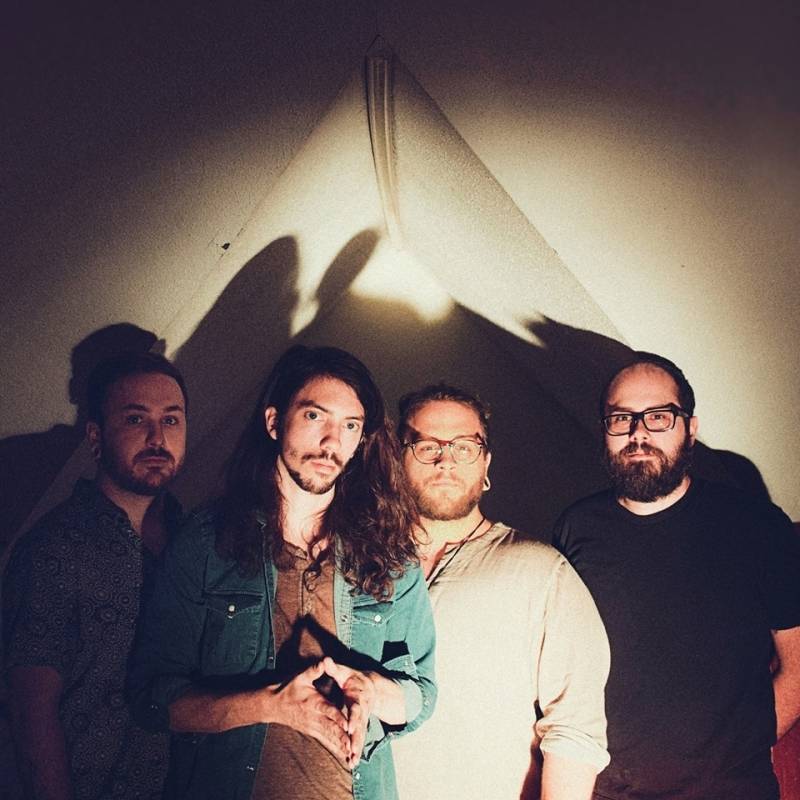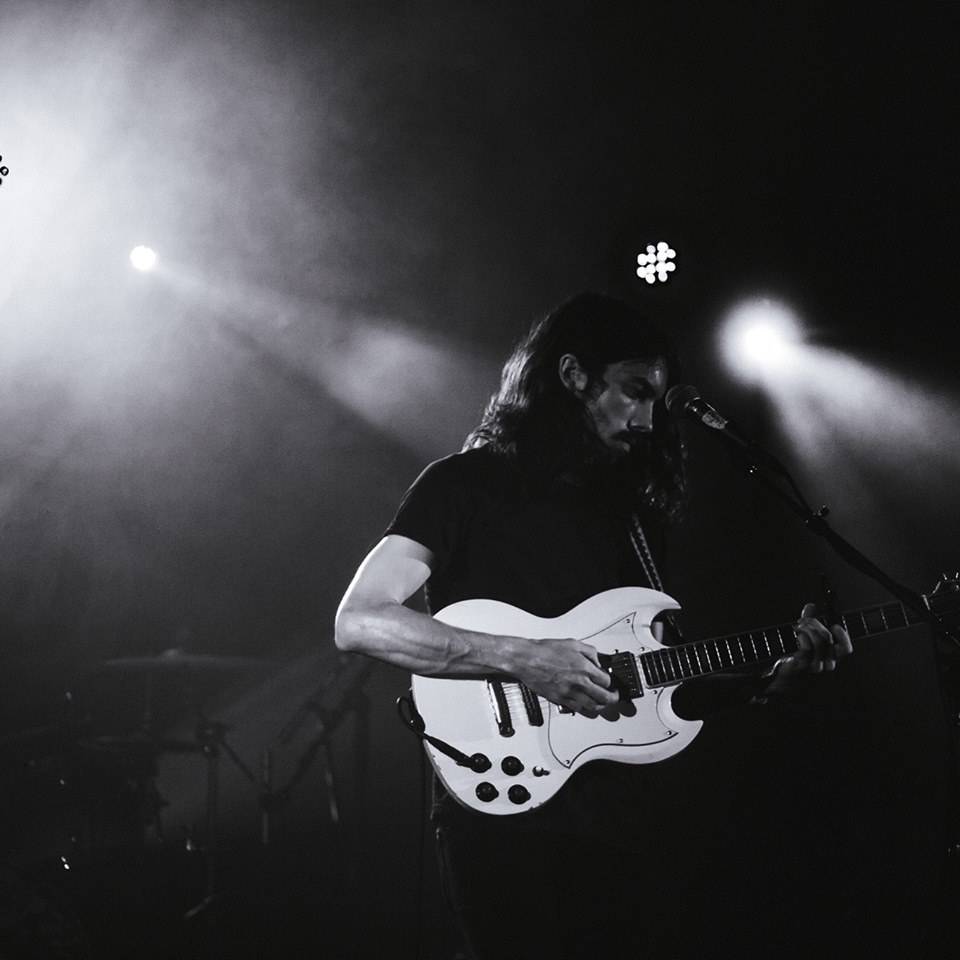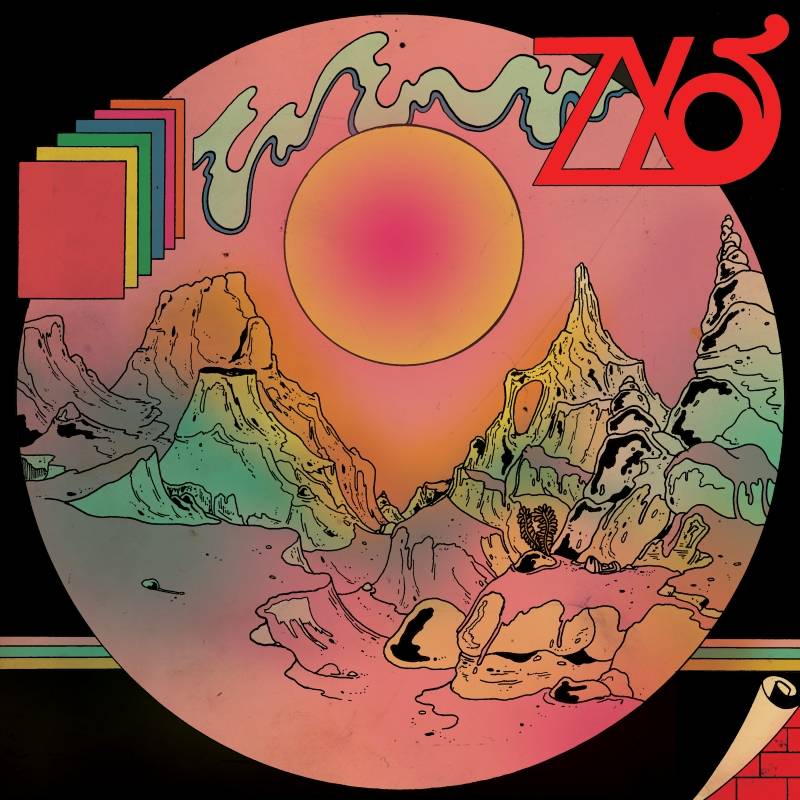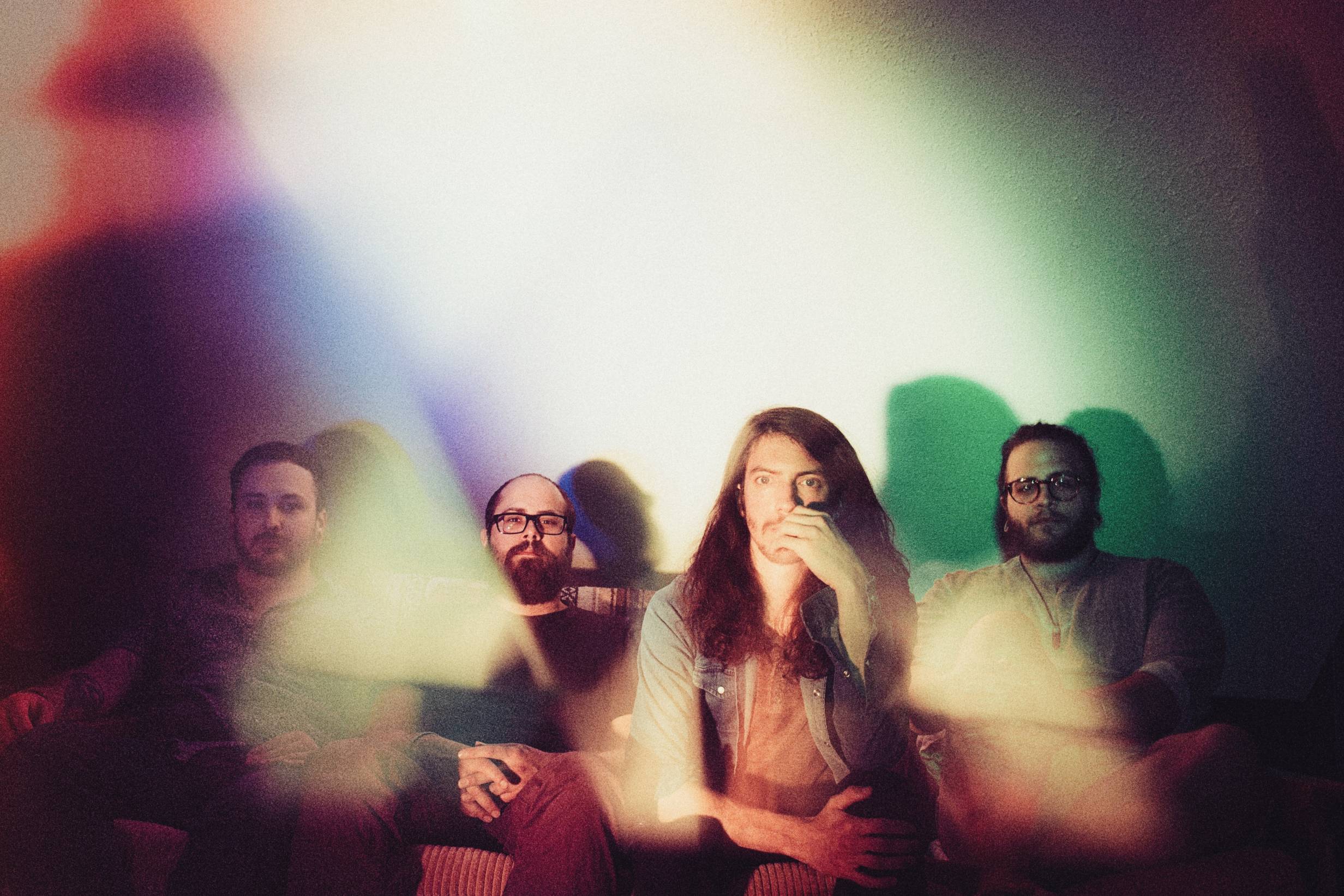I have seen ZXO twice over the last six months, once at Fringe Fest, and once at Pygmalion. The four piece band resonated with me as a psychedelic, proggy, guitar-revival band. They have true riffs and solos. They aren’t afraid of chorus or wah. Talking to frontman Ryan Brewer, I was surprised to learn that he doesn’t necessarily hear it that way. To him, the songs start as mellow, spacious, acoustic ideas, which are then filtered through band’s creative process and instrumentation, and ultimately arrive at their final format as a consequence of organic happenstance, balancing mellow, slow-jam vibes with heavier, more intense moments. ZXO is definitely its own thing.
The band is poised to release its first LP in December, 2017. I met with Ryan at the recently-opened Flying Machine offshoot, Avionics (which was great, by the way), to discuss the band’s process, an existential relationship with a ‘70’s SG-knockoff, and the band’s upcoming release, LP1.

Smile Politely: Why don’t you introduce the band.
Ryan Brewer: Sure. I’m Ryan, I play guitar and sing the songs. Teddy Lerch plays the guitar as well and does some backing vocals. Teddy and I used to play together in a band called Hank. Gabe Gerhardt is our drummer. He’s a high school friend of mine. We used to skateboard together. Garrick Nelson is the newest member. He started playing bass maybe six months ago, back in the spring. I’ve known him since high school as well. I went to two different high schools, and I met Garrick at my first high school, and Gabe at my second high school.
SP: Which high schools did you go to?
Brewer: I am from Champaign originally, but when I was 14, my sophomore year of high school I moved to Arcola. So I went to Champaign Central, where I met Garrick, and then I moved down to Arcola, where I met Gabe.
SP: How does the writing process work for ZXO?
Brewer: Most of the songs, or pretty much all of the songs, I will flesh out on my own, to begin with. I make acoustic demos of every song, and use prerecorded electronic drum beats to get a general sense of the groove of the song. So I’ll flesh out the songs by myself, and then bring them to the band. Inevitably, there is something that isn’t translating from the original recording and we end up taking it in a totally different direction. It’s funny. I used to play in a band called Good Night & Good Morning, that was very much slow jam music, just very slow electric guitar and vibraphone and brushed drums, just really, really chill music–a friend of mine who I knew from back then listened to ZXO and was like, “Wow, you have gone in the polar opposite direction,” and I don’t really see that. I’m doing the same exact thing that I was doing back then–they’re just very slow, mellow, acoustic songs, but when we play them as a full band there’s this added intensity, but it’s still the same thing to me. We try to have a sense of humor about the songs as well, and we don’t try to make it like a really serious art piece or anything like that. Like if there’s a song that I feel is kind of saccharine, or too pretty, we’re not afraid to just throw in a crazy riff, just to make it fun and a little bit like, “You didn’t see that coming.” That was totally the name of the game when Teddy and I played in Hank together. It was just insane time signatures and really weird riffs strung together in really weird ways. So we try to take some of that, and inject that into slower, prettier songs, just to inject a little bit of absurdity into it.
SP: That’s interesting. So, conceptually, you think of your music as more ambient? ZXO strikes me as more of a guitar-rock-revival band.
Brewer: I’ve never really thought of us as a guitar-revival band. That’s just because those are the only instruments that we know how to play.Ted and I just try to dig deep to be the best guitar players that we can be, and just write the most interesting songs that we can, but yeah, I come from an ambient background. So, it’s like, it’s ambient music, but it’s also not afraid to be absurd.

SP: Got it. I respect your use of wah, by the way. No one uses wah anymore. It’s not cool to use the wah, but you guys use it and it works.
Brewer: [laughs] I’ve had enough of people hating on the wah pedal, man. There are so many shows that changed my perception on how cool the wah pedal can be. All these guitarists that I knew were just hating on wah pedals all the time, and really what did it for me was that I was running sound at Pygmalion 2 or 3 years ago, the year that Moon Duo played. They played a super late show at Memphis on Main and I was running sound at that show, and that was the coolest band of the entire festival that year. It’s like hyper repetitive music that’s supposed to put you in a trance, and the guitar player just riffs with a wah pedal for a long time. It’s kind of mind numbing, but in a really cool way. It exposed me to the idea that it is possible to use a wah pedal tastefully.
SP: So that was the moment, where you were like, “Wah is alright.” Talking guitars for a moment, I noticed that you have a “lawsuit-era” Ibanez SG. Any story behind that guitar?
Brewer: SG’s have just always been my favorite guitars. When I finished college in Chicago, I moved to Milwaukee for a few months, because the drummer from Good Night & Good Morning lived there. He worked at a Music Go Round, which is kind of a slightly-less-corporate Guitar Center, that buys and sells used gear. He saw that guitar come in, and he called me and said, “Dude, you gotta come check out this guitar.” So I went in and played it, and was like, “Yeah, this is pretty cool,” and it wasn’t very expensive at all. It’s one of those ‘70’s ripoffs that still has the Gibson headstock shape. They stopped making them a few years after mine was made. I always wonder if there’s this like, metaphysical interaction going on between me and my guitar, where it’s like, someday I need to upgrade that guitar, because it’s a “fake” guitar, and does that make me a fake guitar player? Like one of these days I need to step up and be a “real” guitar player.

SP: Tell me about the album.
Brewer: It was roughly five years in the making. It is kind of a documentation of the changes in the thought process that I’ve gone through in the last five years, transitioning from one type of person, to what I think some people would describe as a completely different type of person.
SP: Can you expound on that?
Brewer: I guess I became a slightly more intentional person in the last few years. Just actively striving more towards the good, rather than wallowing in my own despair. That feeling is what characterized a lot of the music that I was making around 2010, with Good Night & Good Morning. I went down this rabbit hole of, “She doesn’t love me. The perfect person for me doesn’t exist.” I don’t know. I’ve just expanded as a person since then–or I think I have, anyway. So the new record is just trying to accept that side of things, but actively strive towards something better. There is a lot of light and dark on the album. Some of the songs, I would say are really happy, and some have a really melancholy vibe to them. It’s just trying to balance the two, I guess.
SP: Is that reflected in the lyrics, then? What does the lyrical content tend to be about?
Brewer: The lyrical content tends to be about me questioning my own decisions. I’m not much of a lyric listener. I am much more of a music and melody listener, so the lyrics are really secondary to me. That doesn’t mean that I don’t try to make the lyrics meaningful, but it’s just that they aren’t so specific–they don’t pertain to some specific situation in my life, or some specific experience–it’s more about all of the open ended, unanswered questions in my own head. So if you read into the lyrics, you might not be able to pinpoint exactly what situation inspired the lyrics.
SP: You tend to write more abstractly then, versus literally?
Ryan: I don’t get too literal in my lyrics I guess. One of the songs, “Two Arrowheads,” was inspired because I was living on this farm, with my friend Sam Geneser. We were both living there with our girlfriends at the time, and I just had an acoustic guitar, and I went wandering out into the fields when there was a full moon, and I just wanted to write a song that had that kind of vibe to it–just kind of a flowly, late night atmospheric kind of a song.
SP: Any personal favorite tracks from the new album?
Brewer: Favorite to play is probably track 2, it’s called “Two Sashas” I’m really proud of the structure of that song. It plays with intensity and volume changes a lot. There are certain points of it where it feels like you’re driving in the desert, and you hit the overdrive, and it just kicks into high gear. It is just so fun to play. There are times when we play that song, when hit the last note where we just bust out laughing. we’re just like, “Holy shit!” [laughs] If we laugh at the end of it, we played it right. I personally really enjoy the songs that are much more minimal and just have these interesting chord structures in them. “Two Arrowheads” is really fun to play because there is a lot of space in it. I love when we just hit certain notes and let them ring out, and just open up the space. When we hit the balance just right, it feels really good.
SP: Where did you record the album?
Brewer: Mark Wyman hooked us up with a day at Earth Analog, so we got all of the drums done in one day. Then I spent the next year recording the guitars myself, with the help of Sam Geneser. He helped me with some engineering stuff. I did about half of the vocals with a couple of engineers in town: Bryan Bachman and Will Newton at CU Sound Studio. They’re from the band Tried and True. They are great engineers. They have a really cool studio in the same building that the I4C is in. I did the other half on my own at my house. There was some craziness. We got all of the drums recorded, and I spent a few weekends out at me and Sam’s farm studio doing the guitars, and then my girlfriend, bless her heart, accidentally picked up my laptop while my external hard drive was hooked into it, and my hard drive spilled onto the ground and was destroyed. Luckily I had sent the drum tracks off to my drummer via dropbox, so I was able to get the drums back, but I had to redo all of the drums and bass and auxiliary percussion parts. It took a long time because I am kind of obsessive about it. This album took over a year to record. The next one has to be shorter, but I always say that. I’m going to do it faster next time!
SP: Were the spaces where you recorded important?
Brewer: The farm studio, the one out in Argenta that me and Sam put together, out in a farmhouse in the middle of nowhere. It’s got a control room and a live room. It’s a fun little set up out there, because it is very isolated. You can take a walk in the woods if you want to, you can take swim in the pond. It’s nice. That space really gave me the freedom that I needed to experiment with different guitar sounds, and not worry about like, “Oh, I’m paying for this studio time, I have to make it worth it!” I was able to really experiment and take my time.

SP: Tell me about the album art.
Brewer: The artist’s name is Brian Blomerth. He is a comic book artist, who does stuff for Vice and Mary Jane Magazine, occasionally. He did the cover of a record that I absolutely loved, and as soon as I saw that cover, I was like, “I don’t know who made this, but this is what I want.”
SP: What was the process there?
Brewer: I found out his name, and sent him an email. I hadn’t recorded vocals yet, so I sent him all of the instrumental tracks, and told him what the lyrical themes would be. I told him we wanted a front cover, but also a usable logo that we could use for a t-shirt or something. But yeah. He’s got this really fun and cartoony style, but it’s really beautiful. He captures these textures that almost look like 70’s blacklight posters.
SP: Awesome! Thanks for taking the time, Ryan.
Full band photo by Anna Longworth.
Photo of Ted Lerch by Tom Chandler of OddWorld Photography.
Photo of Ryan Brewer by BrownBear Creative.
Album art byBrian Blomerth.








